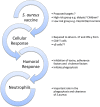Staphylococcus aureus Colonization: Modulation of Host Immune Response and Impact on Human Vaccine Design
- PMID: 24409186
- PMCID: PMC3884195
- DOI: 10.3389/fimmu.2013.00507
Staphylococcus aureus Colonization: Modulation of Host Immune Response and Impact on Human Vaccine Design
Abstract
In apparent contrast to its invasive potential Staphylococcus aureus colonizes the anterior nares of 20-80% of the human population. The relationship between host and microbe appears particularly individualized and colonization status seems somehow predetermined. After decolonization, persistent carriers often become re-colonized with their prior S. aureus strain, whereas non-carriers resist experimental colonization. Efforts to identify factors facilitating colonization have thus far largely focused on the microorganism rather than on the human host. The host responds to S. aureus nasal colonization via local expression of anti-microbial peptides, lipids, and cytokines. Interplay with the co-existing microbiota also influences colonization and immune regulation. Transient or persistent S. aureus colonization induces specific systemic immune responses. Humoral responses are the most studied of these and little is known of cellular responses induced by colonization. Intriguingly, colonized patients who develop bacteremia may have a lower S. aureus-attributable mortality than their non-colonized counterparts. This could imply a staphylococcal-specific immune "priming" or immunomodulation occurring as a consequence of colonization and impacting on the outcome of infection. This has yet to be fully explored. An effective vaccine remains elusive. Anti-S. aureus vaccine strategies may need to drive both humoral and cellular immune responses to confer efficient protection. Understanding the influence of colonization on adaptive response is essential to intelligent vaccine design, and may determine the efficacy of vaccine-mediated immunity. Clinical trials should consider colonization status and the resulting impact of this on individual patient responses. We urgently need an increased appreciation of colonization and its modulation of host immunity.
Keywords: Staphylococcus aureus; T cells; colonization; host response; immunomodulation; microbiota; vaccine.
Figures



Similar articles
-
Protection against Staphylococcus aureus Colonization and Infection by B- and T-Cell-Mediated Mechanisms.mBio. 2018 Oct 16;9(5):e01949-18. doi: 10.1128/mBio.01949-18. mBio. 2018. PMID: 30327437 Free PMC article.
-
Staphylococcal Protein A Contributes to Persistent Colonization of Mice with Staphylococcus aureus.J Bacteriol. 2018 Apr 9;200(9):e00735-17. doi: 10.1128/JB.00735-17. Print 2018 May 1. J Bacteriol. 2018. PMID: 29440258 Free PMC article.
-
Host-Bacterial Crosstalk Determines Staphylococcus aureus Nasal Colonization.Trends Microbiol. 2016 Nov;24(11):872-886. doi: 10.1016/j.tim.2016.06.012. Epub 2016 Jul 26. Trends Microbiol. 2016. PMID: 27474529 Review.
-
Vaccination as infection control: a pilot study to determine the impact of Staphylococcus aureus vaccination on nasal carriage.Vaccine. 2009 Dec 10;28(1):256-60. doi: 10.1016/j.vaccine.2009.09.088. Epub 2009 Sep 30. Vaccine. 2009. PMID: 19799842 Clinical Trial.
-
Host- and microbe determinants that may influence the success of S. aureus colonization.Front Cell Infect Microbiol. 2012 May 4;2:56. doi: 10.3389/fcimb.2012.00056. eCollection 2012. Front Cell Infect Microbiol. 2012. PMID: 22919647 Free PMC article. Review.
Cited by
-
Staphylococcus aureus β-Toxin Exerts Anti-angiogenic Effects by Inhibiting Re-endothelialization and Neovessel Formation.Front Microbiol. 2022 Feb 3;13:840236. doi: 10.3389/fmicb.2022.840236. eCollection 2022. Front Microbiol. 2022. PMID: 35185854 Free PMC article.
-
The Influence of Antibiotic Resistance on Innate Immune Responses to Staphylococcus aureus Infection.Antibiotics (Basel). 2022 Apr 19;11(5):542. doi: 10.3390/antibiotics11050542. Antibiotics (Basel). 2022. PMID: 35625186 Free PMC article. Review.
-
Nasopharyngeal Bacterial Microbiota Composition and SARS-CoV-2 IgG Antibody Maintenance in Asymptomatic/Paucisymptomatic Subjects.Front Cell Infect Microbiol. 2022 Jul 6;12:882302. doi: 10.3389/fcimb.2022.882302. eCollection 2022. Front Cell Infect Microbiol. 2022. PMID: 35873175 Free PMC article.
-
Fibrin(ogen) engagement of S. aureus promotes the host antimicrobial response and suppression of microbe dissemination following peritoneal infection.PLoS Pathog. 2022 Jan 18;18(1):e1010227. doi: 10.1371/journal.ppat.1010227. eCollection 2022 Jan. PLoS Pathog. 2022. PMID: 35041705 Free PMC article.
-
Potential antimicrobial properties of the Ulva lactuca extract against methicillin-resistant Staphylococcus aureus-infected wounds: A review.Vet World. 2021 May;14(5):1116-1123. doi: 10.14202/vetworld.2021.1116-1123. Epub 2021 May 8. Vet World. 2021. PMID: 34220111 Free PMC article. Review.
References
-
- MacNeal WJ, Frisbee FC, McRae MA. Staphylococcemia 1931-1940. Five hundred patients. Am J Clin Pathol (1942) 12:6
-
- Que Y-A, Moreillon P. Staphylococcus aureus (including Staphylococcal Toxic Shock). In: Mandell, Douglas and Bennett’s Principles and Practices of Infectious Diseases. Philadelphia: Elsevier; (2010).
Publication types
LinkOut - more resources
Full Text Sources
Other Literature Sources

